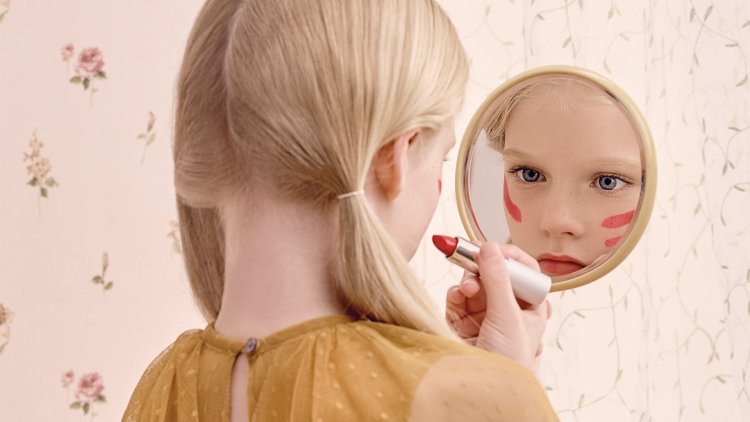The Irony of the Sephora Tweens
Products glorifying youth are being sold to actual youth.

During my time in Seoul—arguably the beauty capital of the world—I witnessed grade-schoolers get mani-pedis, saw 6-year-olds with hair highlights, and was asked by a fellow parent whether my toddler had eyelash extensions. (The answer was no.) These events took place years ago, and the fluency that kids had with cosmetic practices mystified me then. But since returning stateside with three daughters, I’ve begun to think of those experiences as premonitions.
In recent months, “Get ready with me” videos featuring middle-school-age influencers putting sheet masks, lip oils, and moisturizers on their face have been racking up millions of views on TikTok. The app is also rife with stories of Gen Alpha girls cleaning out testers at Sephora. This phenomenon isn’t just anecdotal: In 2023, a survey by the investment bank Piper Sandler found that teen shoppers spent 19 percent more on skin care and 33 percent more on cosmetics than in the year prior.
This early initiation into beauty capitalism has been confusing to many observers: How young is too young for multistep skin-care routines? And what, if anything, are parents supposed to do about this development? The fundamental challenge is that, as I have written, digital feeds and filters are dictating real-world beauty standards. Technology has not only made beauty culture almost inescapable, it has changed what people of all ages expect of their looks.
Several factors have fueled personal care’s creep into younger demographics. Brands such as Bubble and Byoma are intentionally vying for the preteen market; skin-care-devoted Millennials are modeling practices that their kids may mimic; at-home pampering surged during pandemic lockdowns. Then there’s all the time that Generation Alpha spends on screens and social media: Many might learn what products are trending from the TikTok internet personalities they trust—people such as 10-year-old North West, 14-year-old Harper Zilmer, and 18-year-old Katie Fang. “They want to cosplay influencers,” Kelly Atterton, a co-founder of the tween beauty brand Rile, told me.
Since the beauty industry’s beginnings, which coincided with the early days of photography, beauty ideals have spread through mass-market visuals—magazines, film, advertisements. Millennials like me, who spent many weekends in the ’90s milling about the mall, were hardly spared from being marketed personal-care products (Bath & Body Works Sun-Ripened Raspberry gift sets, anyone?). But what was considered “cool” might still have taken months to trickle down from major cities into smaller communities—perhaps through extended relatives or older kids. “Our influences were a lot more local, like when I was growing up I idolized my friend’s older teenage sister,” Atterton said. “Now they watch the same influencers using the same products.”
Today, the stuff sought by sixth graders has an internet-fueled homogeneity, and it spreads much more quickly. No matter where your tween calls home, if they follow the most popular online personalities, they’re exposed to items like Drunk Elephant’s moisturizer, Glow Recipe’s Watermelon Dew Drops serum, and Summer Fridays’ Lip Butter Balms. Added to that is the risk that the TikTok algorithm will show my children beauty content intended for an older audience. My generation ingested YM and Seventeen magazines, but at least the products inside them were age-specific.
The “Sephora tweens” make clear that even though the concept of body acceptance has gained traction culturally, there has not been a blanket rejection of beauty norms for young people. Teens today still worry about their weight, and they have the added burden of worrying earlier about wrinkles. Products glorifying youth are pushed to actual youth: SpoiledChild, a brand that targets Gen Z, sold its anti-aging line with the slogan “Getting old is getting old.” “They’re at the very best their skin is going to be,” Atterton said. “So why use products that are meant for your mom?” (In case it isn’t obvious: The average preteen’s skin does not need many of the products peddled to them on the internet.)
[Read: How to have a realistic conversation about beauty with your kids]
One dermatologist told me he was worried about the growing numbers of young patients coming in with product-related reactions, or wanting to fix perceived flaws. “It becomes a vicious cycle,” Seth Matarasso, based in San Francisco, said. He doesn’t expect these trends to reverse, either. “The battle is on the home front. Have those conversations with your kids.”
Those conversations require balancing the paradoxes of beauty culture. Beauty practices are, at times, empowering, creative, and vessels for self-realization. But TikTok can obfuscate the flip side—that trying to optimize one’s face can become an emotional crutch, a trigger for escalating insecurities. If it’s any consolation to parents, you don’t have to reject kids’ interest in beauty culture outright, because their exposure to it is almost inevitable. Perhaps our job is to provide a wider-angled perspective, reminding them that overindulging in vanity can come with more costs than their favorite influencer might let on.
What's Your Reaction?




















